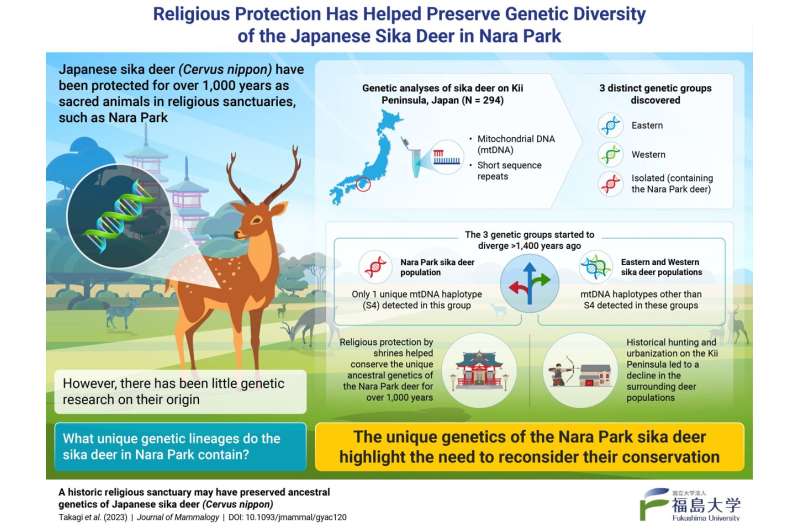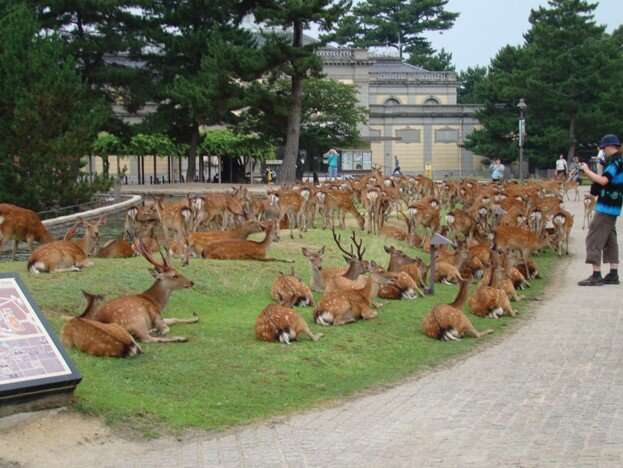This article has been reviewed according to Science X's editorial process and policies. Editors have highlighted the following attributes while ensuring the content's credibility:
fact-checked
peer-reviewed publication
proofread
Conservation of Nara Park deer results in unique genetic lineage

The existing wildlife of a region is heavily shaped over generations by environmental factors and human activity. Activities like urbanization and hunting are known to reduce wildlife populations. However, some cultural or religious practices have, on occasion, preserved local animal populations.
For instance, the forests around religious shrines in Japan have historically forbidden hunting and, as a consequence, provide refuge for certain animal species. A well-known example of this is the Japanese sika deer (Cervus nippon), which has historically been considered a holy creature.
A revered animal that finds mention in many Japanese myths and ancient literature, sika deer have coexisted with humans for centuries. However, human activities like hunting and building settlements have led to fluctuations in their numbers. According to previous studies, Nara Park, located in Japan's northern Kii Peninsula, has been a sanctuary for the deer since ancient times.
Hunting in the forests around important shrines in Nara, like the Kasuga Taisha Shrine and the Todaiji Temple, is strictly prohibited. These religious sanctuaries have thus functioned as protected areas and sheltered wild deer for over a thousand years. The existence of these protected habitats raises some interesting questions. For example, if sika deer have been protected in Nara Park for centuries, is the current deer population here genetically distinct from other sika deer populations in the area?

To seek answers to these questions, a research team from Fukushima University in Japan decided to take a closer look at the genetic structure and history of sika deer on the Kii Peninsula. The study, authored by Associate Professor Shingo Kaneko, along with co-authors Dr. Toshihito Takagi and former Professor of Nara University of Education, Harumi Torii, was published in the Journal of Mammalogy on January 31, 2023.
Talking about the motivation behind this study, Dr. Takagi comments, "Legend has it that the sika deer in Nara Park had long been strictly protected as messengers of the gods. Today, these deer are one of the most popular tourist attractions in Japan. However, there has been little genetic research on the origin of these deer. Therefore, we conducted a genetic analysis of sika deer in Nara Park and the surrounding areas to better understand their origin."
The team collected 294 muscle and blood samples of sika deer from 30 sites on the Kii Peninsula between 2000 and 2016, and classified them into eight populations spanning the Western, Central, and Eastern Kii regions. The genomic DNA was extracted and analyzed for two genetic entities: short sequence repeats (SSR), which are inherited from both parents and tend to change frequently during evolution, and mitochondrial DNA (mtDNA), which is only passed down from mother to offspring.
The deer population was first screened for gene sets in the mtDNA that were inherited together, also known as a haplotype. The team found 18 different haplotypes but with a low diversity across populations.
Using this information, they identified three distinct genetic groups, of which only one had a unique haplotype (S4), indicating a very restricted flow of genes across its maternal lineage. Interestingly, this isolated group included the deer around the Kasuga Taisha Shrine. "This could be possible as the female sika deer tend to migrate less and prefer to remain in their own natal habitat," explains Dr. Takagi.
So, when did these deer start to diverge from their ancestors? According to the authors, the Nara Park deer population split from their ancestors more than 1,400 years ago, around the exact time the Kasuga Taisha Shrine was established. The eastern and western groups, constituting the current Kii Peninsula population, more recently diverged from their ancestor.
When asked what exactly caused the divergence and how they managed to maintain this distinct gene pool, Dr. Takagi says, "Generally, Japanese sika deer populations have been negatively impacted by habitat fragmentation and regional extinction owing to human activities. Our research shows that the religious protection helped rare ancestral populations of sika deer survive in Nara Park for more than 1,000 years, while the surrounding populations disappeared due to historical hunting and settlement."
As a result of the shrine's conservation efforts, the number of sika deer in Nara Park has increased. At the same time, the population of deer is increasing in the surrounding area, and the damage to agriculture and forestry is becoming severe. For the first time in centuries, they are in contact with deer in the surrounding areas, posing a threat to their preserved genetic identity. With this new piece of evidence, it is time to carefully reconsider their conservation based on the management plan, including the surrounding area.
The research is published in the Journal of Mammalogy.
More information: Toshihito Takagi et al, A historic religious sanctuary may have preserved ancestral genetics of Japanese sika deer (Cervus nippon), Journal of Mammalogy (2023). DOI: 10.1093/jmammal/gyac120
Journal information: Journal of Mammalogy
Provided by Fukushima University




















